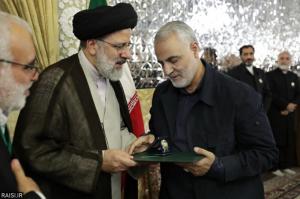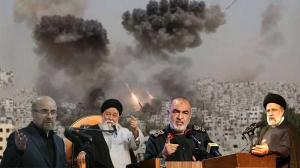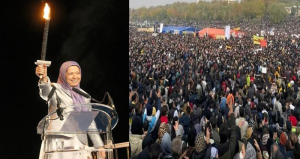Iranian officials have been vocal in their responses to recent events, particularly in the aftermath of the suspicious explosions in Kerman. Despite the claims of responsibility by ISIS , Iranian state officials sought to exploit it in different ways.

Raisi said, “Leaders of the resistance rightly designate Haj Qasem Soleimani as the martyr of Al-Quds. The current state of the Resistance reflects his support, follow-ups, management, and actions. We must also appreciate Hamas and Hezbollah.”

Ahmad Alamolhoda, “Today, Israel’s apprehensions extend beyond Gaza and Palestine, finding itself surrounded. The Popular Mobilization Forces in Iraq target America, indirectly affecting Israel. Ansarallah in Yemen controls the seas, destroying Israeli ships.”
Alamolhoda ,” A week prior of his martyrdom, Soleimani had discreetly visited Gaza three times, playing a pivotal role in establishing tunnels over there.”
— NCRI
PARIS, FARANCE, January 10, 2024 /EINPresswire.com/ — The National Council of Resistance of Iran (NCRI) Foreign Affairs Committee in an article published that Iranian officials have been vocal in their responses to recent events, particularly in the aftermath of the suspicious explosions in Kerman. Despite the claims of responsibility by ISIS and the endorsement of this narrative by Western governments, Iranian state officials sought to exploit it in different ways.
In their frantic remarks, while the highest-ranking officials attempted to project power, making excessive use of terms like “power” and “strength,” simultaneously, they navigated political nuances and took precautions. Whilst proudly claiming responsibility for the October 7 attacks in an attempt to boost the morale of a confused domestic and regional audience, they sought to do so without drawing undue international scrutiny.
In their communications, they have tactfully alluded to the regime’s involvement in the attacks, framing it as “an inspirational directive” orchestrated by the slain Quds Force commander, Qasem Soleimani.
Ebrahim Raisi, the president of the regime, attributed the creation of ISIS to Israel, even though the Hashd al-Shaabi militias were established by the regime in Iraq under the pretext of combating ISIS almost a decade ago, bolstering Tehran’s grip on its western neighbor.
Raisi said, “Leaders of the resistance rightly designate Haj Qasem Soleimani as the martyr of Al-Quds. The current state of the Resistance reflects his support, follow-ups, management, and actions. While acknowledging Palestine, we must also appreciate Hamas and Hezbollah.
Yet, Haj Qasem’s role has been incomparable. He tirelessly worked day and night, contributing to the security we enjoy in the region today. In our beloved country, he thwarted the American plan, doing a remarkable job.”
Addressing the audience at Tehran’s Khomeini Mosque, he added, “The enemy is aware that Iran stands strong today, as a champion generating power. Haj Qasem played a crucial role in creating and enhancing the country’s strength. We believe that the resolution of the Al-Aqsa Storm will signify the end of the Zionist regime. Inshallah.”
Delivering a speech on January 5 at a cemetery in Tehran, Mohammad Bagher Ghalibaf, the Speaker of the regime’s Parliament, said, “The esteemed martyr Soleimani served as a soldier under the revered leadership of the Supreme Leader, and His Eminence directly commanded him. We observed the capabilities of this beloved martyr, and he himself witnessed them.”
He continued, “In Operation Al-Aqsa Storm, they executed a mission and struck a blow to the Zionist regime at the zenith of its power. Over the span of seventy-five years, such extensive damage and impact, both in material and credibility, had not been collectively inflicted. These exceptional qualities define the persona of Martyr Soleimani.”
Also on January 5, Ahmad Alamolhoda, the representative of the regime’s Supreme Leader in Mashhad, delivered a speech, stating, “The Supreme Leader emphasized that Haj Qasem Soleimani transformed resistance into a formidable front.
Today, Israel’s apprehensions extend beyond Gaza and Palestine, finding itself surrounded. The Popular Mobilization Forces in Iraq target America, indirectly affecting Israel. Ansarallah in Yemen controls the seas, intercepting and destroying Israeli ships.
Hezbollah in Lebanon poses a threat from the sky. This Resistance Front, as highlighted by the Supreme Leader, was established and actualized by the late Martyr Haj Qasem Soleimani. The plan of the Al-Aqsa Storm is a manifestation of the sacrifices, leadership, and strategies of Martyr Haj Qasem Soleimani.
He recently took on the role of heading Hamas in Beirut before his martyrdom. A week prior, he shared that Martyr Haj Qasem Soleimani had discreetly visited Gaza three times, playing a pivotal role in establishing tunnels over there.
The visionary leadership and ideas of Martyr Haj Qasem Soleimani gave birth to the Al-Aqsa Storm movement, providing a blueprint for Palestinian Resistance, now bearing fruit. When asserting that Al-Aqsa Storm is the legacy of Martyr Haj Qasem, it’s not an exaggeration or a mere claim; it’s a testament to his profound impact.”
Alamolhoda added, “Ismail Haniyeh, the Political Chief of Hamas, attended the funeral procession of Martyr Haj Qasem in Tehran. During the event, he emphasized, ‘We should recognize this martyr as the ‘Martyr of Al-Quds’ because of his ability to liberate the land of Jerusalem and the Al-Aqsa Mosque from the grip of Israel.
The Al-Aqsa Storm emerged from the strategic planning and ideas of Martyr Haj Qasem Soleimani. He also played a guiding role in Yemen, where the revolution and resistance stemmed from his concepts. Following Haj Qasem’s vision, they have reached a point where they now directly confront the United States in the Red Sea. This stands as a testament to the visionary thinking of Martyr Haj Qasem.”
One day after Soleimani’s anniversary, Hossein Salami, the Commander-in-Chief of the Islamic Revolutionary Guard Corps, made a visit to Kerman to reiterate the same message.
In his address, Salami said, “The Al-Aqsa Storm beautifully demonstrated the vulnerability of this artificial and deceitful regime. Today, at least twenty Zionists in Gaza are eliminated daily by the heroic Palestinians. Tanks are struck. The armor is shattered. The bones of Zionists and their officials are broken, and they no longer envision a positive outlook for a secure life in that sacred land in the near future.”
He added, “So, understand this: the blows they have received have been severe, harsh, painful, and intolerable. Today, Zionist officials have no way to escape from this destructive quagmire. They should leave the scene. They have been defeated. “
The Middle East is engulfed in turmoil, with the international community scrambling for a solution. Amidst this chaos, a potential remedy may be closer than we think. Since the conflict erupted in Gaza, various theories have surfaced regarding its origins and possible resolutions. Despite sincere efforts to end the war, many politicians propose a more direct approach to ending terrorism: targeting the source.
For decades, the world has suffered from Islamic fundamentalism. Millions have fallen victim to what first started in Iran in 1979 when fanatics, headed by Ruhollah Khomeini, hijacked a truly democratic revolution that aimed for “independence, freedom, and a republic.”
Soon after taking power in Iran, the religious tyranny began its killing spree under the banner of “Islam.” Tens of thousands of innocent civilians and dissidents, mostly Shiite Muslims, were sent to the gallows by the rulers of the so-called “Islamic World’s Pole.”
Yet, western countries turned a blind eye to the Iranian people’s suffering and their struggle for freedom and democracy. To please the ayatollahs more, Western democracies shackled the Iranian Resistance movement for years through many means, thus hindering the process of regime change in Iran by its people and opposition.
In tandem with human rights abuses, the Iranian theocracy exported terrorism, using it as a tool to suppress dissent. The infamous quote “The road to Jerusalem passes through Karbala” ignited the eight-year Iran-Iraq war, serving as a smokescreen for domestic crises. Even after a cease-fire, Tehran continued its aggressive stance through various means, directly and indirectly supporting terrorism in the region.
Tehran was forced to accept a cease-fire with Iraq, due to both domestic and international pressure, but it never yielded its adventurism. Loyal to Khomeini’s heritage, his successors continued the export of terrorism both directly through the Revolutionary Guards and its extraterritorial forces, the Quds Force, and indirectly, through many proxy groups in the region.
While the Iranian regime has so far dodged the consequences of its involvement in the current war in the region and tried to reject any responsibility whatsoever, some officials have acknowledged their role as the epicenter of terrorism.
A few days before the anniversary of the death of Qassem Soleimani, the eliminated Quds Force commander, the Islamic Revolutionary Guards Corps (IRGC) spokesperson Ramezan Sharif claimed that the October 7 attack was “one of the retaliations of the Axis of Resistance” for the so-called “martyrdom of Qasem Soleimani.” On January 4, Ahmad Alamolhoda, the representative of the regime’s supreme leader Ali Khamenei in Khorasan province, claimed that “Soleimani planned and oversaw the construction of underground tunnels in Gaza.”
There is no need to peer into the gloom to see that the “head of the snake” is in Tehran. Facing an explosive society, Iran’s crisis-riddled regime needs blood and crises to hold its grip on power. In 1988, when Khomeini accepted the ceasefire with Iraq, or what he considered the “chalice of poison,” he ordered the massacre of 30,000 political prisoners, who were mostly members and supporters of Iran’s principal opposition group, the Mujahedin-e-Khalq (MEK).
Congruent with its terrorist activities in the region, Tehran has yet again increased its human rights violations. According to reports tallied by the Iranian Resistance, there have been at least 864 executions in Iran in 2023. What else is expected from a regime that has Ebrahim Raisi, one of the key perpetrators of the 1988 massacre, as its president?
An effective strategy to end the bloodshed is to target the head of the snake in Iran and deter the warmongering mullahs. To achieve this, the world community must:
1. Blacklist the IRGC entirely and increase sanctions on the regime for its terrorist activities.
2. Support the Iranian people’s aspiration for a secular, non-nuclear republic.
3. Hold the regime accountable for four decades of crimes against humanity, prosecuting key figures like Raisi and Khamenei for their roles in the 1988 massacre and subsequent executions.
As Dietrich Bonhoeffer, German Lutheran pastor, theologian, and anti-Nazi dissident, put it, “Silence in the face of evil is itself evil: not to speak is to speak. Not to act is to act.”
To subscribe weekly Newsletter of NCRI, please use this link. https://bit.ly/3SMgEla
Shahin Gobadi
NCRI
+33 6 61 65 32 31
email us here
The Iranian regime has so far dodged the consequences of its involvement in the current war in the region and tried to reject any responsibility whatsoever.
![]()
Originally published at https://www.einpresswire.com/article/680275891/video-navigating-ambiguity-understanding-iranian-officials-perspectives-on-october-7-incidents




